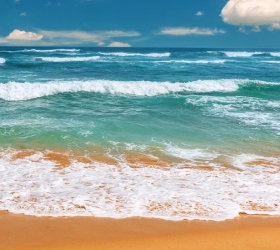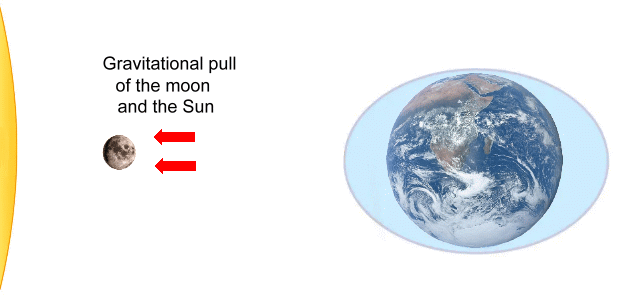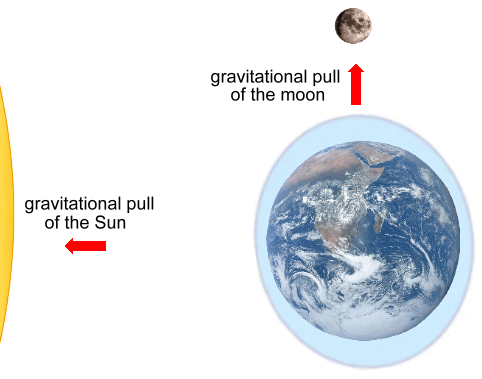  High and low tides are caused by the moon, and to a lesser extent, the Sun. The gravitational pull from these generates something called the tidal force. The tidal force from the moon, for example, causes Earth and its water to bulge out on the side closest to the moon and the side farthest from the moon.
High and low tides are caused by the moon, and to a lesser extent, the Sun. The gravitational pull from these generates something called the tidal force. The tidal force from the moon, for example, causes Earth and its water to bulge out on the side closest to the moon and the side farthest from the moon.As the Earth rotates, every region of Earth passes through both of these bulges each day. When you're in one of the bulges, you experience a high tide. When you're not in one of the bulges, you experience a low tide. This cycle of two high tides and two low tides occurs most days on most of the coastlines of the world. The tidal force is really just gravity, of course. As Earth rotates, the moon's gravity pulls on different parts of our planet. Even though the moon only has about 1/100th the mass of Earth, since it's so (relatively) close to us, it has enough gravity to move things around. The moon's gravity even pulls on the land, but not enough for anyone to tell, unless they use special, really precise instruments. On the opposite side of the Earth, or the far side away from the moon, the gravitational attraction of the moon is less because it is farther away. Here, inertia exceeds the gravitational force, and the water tries to keep moving away from the Earth, also forming a bulge. Let's pause for a moment and consider the vast distances involved. Below is a diagram of the Earth-moon system, drawn approximately to scale. It's impossible to show the Sun in the same picture, unless you reduce everything to barely visible dots.  In real life, the Earth isn't a global ocean, covered in an even layer of water. There are seven continents, and all that land gets in the way. The continents prevent the water from perfectly following the moon's pull. That's why in some places, the difference between high and low tide isn't very big, and in other places, the difference is drastic. 
The Sun causes tides just like the moon does, although they are somewhat smaller. When the earth, moon, and Sun line up, which happens at full moon or new moon, the lunar and solar tides reinforce each other, leading to more extreme tides, called spring tides.  During the rest of the month, the tides won't be as large. During neap tides, when the Moon and Sun's gravitational force act at 90° to each other (making a right angle to the Earth's orbit), the difference between high and low tides is smallest. Neap tides occur at the first and third quarters of the lunar phases. Tidal forces around masses much heavier than the Sun can be incredibly powerful. 'Tidal forces' refer to the distortion of one object by another due to the difference in the gravitational pull on the near and far side of an object, such as an orbiting spacecraft, for example. Due to a neutron star or black hole's extreme density, objects in their vicinity would experience extreme gravity and extreme tidal forces that could pull the spacecraft and its occupants apart. Find out more by reading the short story 'Neutron Star' by author Larry Niven |